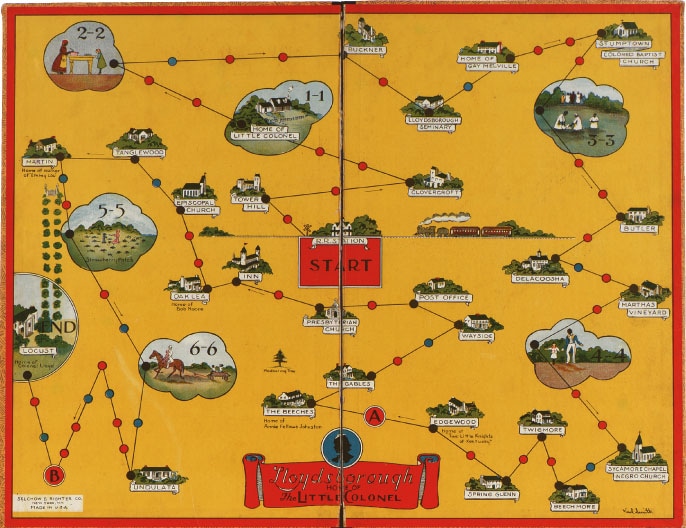Little Colonel Board Game by Selchow & Righter
At one time, Selchow & Righter, the makers of Parcheesi, Scrabble and Trivial Pursuit, ranked with Parker Brothers and Milton Bradley as one of the nation’s top three board game manufacturers. They introduced The Little Colonel game in the mid-1930s to capitalize on the popularity of Fox Film’s “The Little Colonel” movie. The game was one of many merchandise spin-offs after the film premiered in 1935. Among the collectibles highly-prized today are Shirley Temple dolls, clothing, fabric, handkerchiefs and books.
The board design is based on a map and a photograph album put together by the residents of Pewee Valley to help Fox Film with the movie. The letter accompanying the portfolio stated:
...Since the author (editor's note: Annie Fellows Johnston) created neither the environment nor the character and made them living and vital for the rest of us through her accurate portrayal of real people and real places, it occurred to me that actual photographs of such characters and places might be a medium through which a clever director could find the essence of what has made "The Little Colonel" such a potent factor in the lives of two generations of Americans...
The final artwork was created by Little Colonel Hattie Cochran’s first cousin, Karl J. Smith, who summered at Beechmore (his grandparents' home) from 1900 to 1905 and spent his tenth birthday there, according to a letter he wrote to Pewee Valley Historian Lee Heiman on October 10, 1969.
...Since the author (editor's note: Annie Fellows Johnston) created neither the environment nor the character and made them living and vital for the rest of us through her accurate portrayal of real people and real places, it occurred to me that actual photographs of such characters and places might be a medium through which a clever director could find the essence of what has made "The Little Colonel" such a potent factor in the lives of two generations of Americans...
The final artwork was created by Little Colonel Hattie Cochran’s first cousin, Karl J. Smith, who summered at Beechmore (his grandparents' home) from 1900 to 1905 and spent his tenth birthday there, according to a letter he wrote to Pewee Valley Historian Lee Heiman on October 10, 1969.
It depicts “Lloydsborough Valley (editor's note: Annie Fellows Johnston's pseudonym for Pewee Valley in the Little Colonel novels), its homes, churches and other points of interest,” according to the explanation inside the box. Many of these “points of interest” were actually part of the stories, including Locust, Tanglewood, Oaklea, the Episcopal Church, the Home of the Little Colonel, Undulata, The Beeches, The Gables, Edgewood, Beechmore, “Stumptown” Baptist Church, the Home of Gay Melville, the Post Office, the Inn, the Presbyterian Church, Lloydsborough Seminary (in real life, the Kentucky College for Young Ladies), Clovercroft and the R.R. Station. Delacoosha was important because it was while staying here that Annie Fellows Johnston met the inspirations for her very first book in the series, “The Little Colonel.”
Game pieces were based on characters featured in the movie and included Fritz (5), the Little Colonel’s Scotch and Skye terrier; the Little Colonel (35) Lloyd Sherman; Old Colonel Lloyd (30), her grandfather; the Little Colonel’s mother (25), Mrs. Sherman; Walker (20), the Old Colonel’s man-servant; Mom Beck (20), the Little Colonel’s nurse; May Lilly (10), and Henry Clay (5), the little colonel's playmates.
Game pieces were based on characters featured in the movie and included Fritz (5), the Little Colonel’s Scotch and Skye terrier; the Little Colonel (35) Lloyd Sherman; Old Colonel Lloyd (30), her grandfather; the Little Colonel’s mother (25), Mrs. Sherman; Walker (20), the Old Colonel’s man-servant; Mom Beck (20), the Little Colonel’s nurse; May Lilly (10), and Henry Clay (5), the little colonel's playmates.
Related Links








